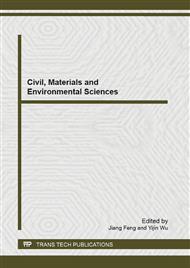[1]
Fookes, P.G. (1988). The geology of carbonate soils and rocks and their engineering characterisation and description.Proc., Int. Conf. Calcareous Sediments, Perth, Western Australia, ISSMFE, Vol. 2,pp.787-805.
Google Scholar
[2]
Noorany, I. (1989). Classification of Marine sediments.ASCE Journal of Geotechnical Engineering, Vol. 115, No.1, pp.23-37.
Google Scholar
[3]
Semple, R. (1988). State of the art report on engineering properties of carbonate soils.Proc. Int. Conf. Calcareous Sediments, Perth, Vol. 2, pp.807-836.
Google Scholar
[4]
Airey, D.W., Randolph, M.F. and Hyden, A.M. (1988). The strength and stiffness of two calcareous sands.Proc. 1st Int. Conf. on Calcareous Sediments, Perth, Australia. Vol. 1, 43-50.
Google Scholar
[5]
Coop, M.R. (1990). "The mechanics of uncemented carbonate sands". Geotechnique, 40, No. 4, pp.607-626.
DOI: 10.1680/geot.1990.40.4.607
Google Scholar
[6]
Carter, J.P., Airey, D.W. and Fahey, M. (2000). A review of laboratory testing of calcareous soils.The Second International conference on Engineering for Calcareous sediments, Manama, Bahrain, Vol. 1, Rotherdam, A.A. Balkema, pp.401-430.
Google Scholar
[7]
Alba.,I.L., Audibert, J.M.E.(1999). Pile design in calcareous and carbonate granular material. An historical overview.The Second International conference on Engineering for Calcareous sediment, Manama, Bahrain, Vol. 1, Rotherdam, A. A. Balkema, pp.29-49.
Google Scholar
[8]
Foray, P.Y, Nauroy, J.F, and Colliat, J.L. (1999). Mechanisms governing the behaviour of carbonate sands and influence on the design of deep foundations. The Second International conference on Engineering for Calcareous sediments, Manama, Bahrain, Vol. 1, Rotherdam, A.A. Balkema, pp.55-68.
Google Scholar
[9]
Randolph, M.F. and Erbrich, C. (2000). Design of shallow foundations for calcareous sediments.The Second International conference on Engineering for Calcareous sediments, Manama, Bahrain, Vol. 1,Rotherdam, A.A. Balkema, pp.361-377.
Google Scholar
[10]
Grine, K. (2002). An investigation of the stability of carbonate sand.PhD thesis, Department of Civil Engineering, University of Newcastle upon-Tyne, UK.
Google Scholar
[11]
Grine, K., and Glendinnig, S. (2007). Creation of an Artificial carbonates Sand. Geotechnical and Geological Engineering Journal. Vol. 25, No. 4, pp.441-448.
Google Scholar
[12]
Coop, M.R. and Atkinson, J.H. (1993). Mechanics of cemented carbonate sands.Geotechnique, 43(1), pp.53-67.
Google Scholar
[13]
Allman, M.A., and Poulos, H.G. (1988).Stress-strain behaviour of an artificially cemented calcareous soil.Proc. 1st Int. conf. on Calcareous Sediments, Perth, Australia. Vol. 1, pp.51-60.
Google Scholar


